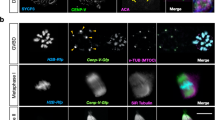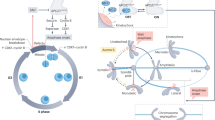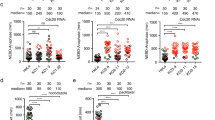Abstract
The spindle-assembly checkpoint ensures that, during mitosis and meiosis, chromosomes do not segregate until they are properly attached to the microtubules of the spindle. Here we show that mdf-1 and mdf-2 are components of the spindle-assembly checkpoint in Caenorhabditis elegans, and are essential for the long-term survival and fertility of this organism. Loss of function of either of these genes leads to the accumulation of a variety of defects, including chromosome abnormalities, X-chromosome non-disjunction or loss, problems in gonad development, and embryonic lethality. Antibodies that recognize the MDF-2 protein localize to nuclei of the cleaving embryo in a cell-cycle-dependent manner. mdf-1, a gene encoding a product that interacts with MDF-2, is required for cell-cycle arrest and proper chromosome segregation in premeiotic germ cells treated with nocodoazole, a microtubule-depolymerizing agent. In the absence of mdf gene products, errors in chromosome segregation arise and accumulate, ultimately leading to genetic lethality.
This is a preview of subscription content, access via your institution
Access options
Subscribe to this journal
Receive 12 print issues and online access
$209.00 per year
only $17.42 per issue
Buy this article
- Purchase on Springer Link
- Instant access to full article PDF
Prices may be subject to local taxes which are calculated during checkout






Similar content being viewed by others
References
Elledge, S. J. Cell cycle checkpoints: preventing an identity crisis. Science 274, 1664–1672 (1996).
Rudner, A. D. & Murray, A. W. The spindle assembly checkpoint. Curr. Opin. Cell Biol. 8, 773–780 (1996).
Gorbsky, G. J. Cell cycle checkpoints: arresting progress in mitosis. Bioessays 19, 193–197 (1997).
Nicklas, R. B. How cells get the right chromosomes. Science 275, 632–637 (1997).
Hardwick, K. G. The spindle checkpoint. Trends Genet. 14, 1–4 (1998).
Li, R. & Murray, A. W. Feedback control of mitosis in budding yeast. Cell 66, 519–531 (1991).
Hoyt, M. A., Totis, L. & Roberts, B. T. S. cerevisiae genes required for cell cycle arrest in response to loss of microtubule function. Cell 66, 507–517 (1991).
Li, Y. & Benezra, R. Identification of a human mitotic checkpoint gene: hsMAD2. Science 274, 246–248 (1996).
Chen, R. H., Waters, J. C., Salmon, E. D. & Murray, A. W. Association of spindle assembly checkpoint component XMAD2 with unattached kinetochores. Science 274, 242–246 (1996).
Gorbsky, G. J., Chen, R. H. & Murray, A. W. Microinjection of antibody to Mad2 protein into mammalian cells in mitosis induces premature anaphase. J. Cell Biol. 141, 1193–1205 (1998).
Waters, J. C., Chen, R.-H., Murray, A. W. & Salmon, E. D. Localization of Mad2 to kinetochores depends on microtubule attachment, not tension. J. Cell Biol. 141, 1181–1191 (1998).
He, X., Patterson, T. E. & Sazer, S. The Schizosaccharomyces pombe spindle checkpoint protein mad2p blocks anaphase and genetically interacts with the anaphase-promoting complex. Proc. Natl Acad. Sci. USA 94, 7965–7970 (1997).
Li, Y., Gorbea, C., Mahaffey, D., Rechsteiner, M. & Benezra, R. MAD2 associates with the cyclosome/anaphase-promoting complex and inhibits its activity. Proc. Natl Acad. Sci. USA 94, 12431–12436 (1997).
Page, A. M. & Hieter, P. The anaphase-promoting complex: new subunits and regulators. Annu. Rev. Biochem. 68, 583–609 (1999).
Fang, G., Yu, H. & Kirschner, M. W. The checkpoint protein MAD2 and the mitotic regulator CDC20 form a ternary complex with the anaphase-promoting complex to control anaphase initiation. Genes Dev. 12, 1871–1883 (1998).
Hwang, L. H. et al. Budding yeast Cdc20: a target of the spindle checkpoint. Science 279, 1041–1044 (1998).
Lorca, T. et al. Fizzy is required for activation of the APC/cyclosome in xenopus egg extracts. EMBO J. 17, 3565–3575 (1998).
Kallio, M., Weinstein, J., Daum, J. R., Burke, D. J. & Gorbsky, G. J. Mammalian p55CDC mediates association of the spindle checkpoint protein Mad2 with the cyclosome/anaphase-promoting complex, and is involved in regulating anaphase onset and late mitotic events. J. Cell Biol. 141, 1393–1406 (1998).
Kim, S. H., Lin, D. P., Matsumoto, S., Kitazono, A. & Matsumoto, T. Fission yeast Slp1: an effector of the Mad2-dependent spindle checkpoint. Science 279, 1045–1047 (1998).
Wassmann, K. & Benezra, R. Mad2 transiently associates with an APC/p55Cdc complex during mitosis. Proc. Natl Acad. Sci. USA 95, 11193–11198 (1998).
Taagepera, S., Campbell, M. S. & Gorbsky, G. J. Cell-cycle-regulated localization of tyrosine and threonine phosphoepitopes at the kinetochores of mitotic chromosomes. Exp. Cell Res. 221, 249–260 (1995).
Fukushige, T., Hawkins, M. G. & McGhee, J. D. The GATA-factor elt-2 is essential for formation of the Caenorhabditis elegans intestine. Dev. Biol. 198, 286–302 (1998).
Hardwick, K. G. & Murray, A. W. Mad1p, a phosphoprotein component of the spindle assembly checkpoint in budding yeast. J. Cell Biol. 131, 709–720 (1995).
Chen, R. H., Shevchenko, A., Mann, M. & Murray, A. W. Spindle checkpoint protein Xmad1 recruits Xmad2 to unattached kinetochores. J. Cell Biol. 143, 283–295 (1998).
Fire, A. et al. Potent and specific genetic interference by double-stranded RNA in Caenorhabditis elegans. Nature 391, 806–811 (1998).
O’Connell, K. F., Leys, C. M. & White, J. G. A genetic screen for temperature-sensitive cell-division mutants of Caenorhabditis elegans. Genetics 149, 1303–1321 (1998).
McCarter, J., Bartlett, B., Dang, T. & Schedl, T. Soma-germ cell interactions in Caenorhabditis elegans: multiple events of hermaphrodite germline development require the somatic sheath and spermathecal lineages. Dev. Biol. 181, 121–143 (1997).
Iwasaki, K., McCarter, J., Francis, R. & Schedl, T. emo-1, a Caenorhabditis elegans Sec61p gamma homologue, is required for oocyte development and ovulation. J. Cell Biol. 134, 699–714 (1996).
Rose, K. L. et al. The POU gene ceh-18 promotes gonadal sheath cell differentiation and function required for meiotic maturation and ovulation in Caenorhabditis elegans. Dev. Biol. 192, 59–77 (1997).
Berry, L. W., Westlund, B. & Schedl, T. Germ-line tumor formation caused by activation of glp-1, a Caenorhabditis elegans member of the Notch family of receptors. Development 124, 925–936 (1997).
Francis, R., Barton, M. K., Kimble, J. & Schedl, T. gld-1, a tumor suppressor gene required for oocyte development in Caenorhabditis elegans. Genetics 139, 579–606 (1995).
Francis, R., Maine, E. & Schedl, T. Analysis of the multiple roles of gld-1 in germline development: interactions with the sex determination cascade and the glp-1 signaling pathway. Genetics 139, 607–630 (1995).
Kadyk, L. C. & Kimble, J. Genetic regulation of entry into meiosis in Caenorhabditis elegans. Development 125, 1803–1813 (1998).
Qiao, L. et al. Enhancers of glp-1, a gene required for cell-signaling in Caenorhabditis elegans, define a set of genes required for germline development. Genetics 141, 551–569 (1995).
Seydoux, G., Schedl, T. & Greenwald, I. Cell-cell interactions prevent a potential inductive interaction between soma and germline in C. elegans. Cell 61, 939–951 (1990).
Graham, P. L., Schedl, T. & Kimble, J. More mog genes that influence the switch from spermatogenesis to oogenesis in the hermaphrodite germ line of Caenorhabditis elegans. Dev. Genet. 14, 471–484 (1993).
Graham, P. L. & Kimble, J. The mog-1 gene is required for the switch from spermatogenesis to oogenesis in Caenorhabditis elegans. Genetics 133, 919–931 (1993).
Tugendreich, S., Tomkiel, J., Earnshaw, W. & Hieter, P. CDC27Hs colocalizes with CDC16Hs to the centrosome and mitotic spindle and is essential for the metaphase to anaphase transition. Cell 81, 261–268 (1995).
Jin, D.-Y., Spencer, F. & Jeang, K.-T. Human T cell leukemia virus type 1 oncoprotein Tax targets the human mitotic checkpoint protein MAD1. Cell 93, 81–91 (1998).
Hodgkin, J. A., Horvitz, H. R. & Brenner, S. Nondisjunction mutants of the nematode Caenorhabditis elegans. Genetics 91, 67–94 (1979).
Hyman, A. A. & White, J. G. Determination of cell division axes in the early embryogenesis of Caenorhabditis elegans. J. Cell Biol. 105, 2123–2135 (1987).
Dasso, M. & Newport, J. W. Completion of DNA replication is monitored by a feedback system that controls the initiation of mitosis in vitro: studies in Xenopus. Cell 61, 811–823 (1990).
Minshull, J., Sun, H., Tonks, N. K. & Murray, A. W. A MAP kinase-dependent spindle assembly checkpoint in Xenopus egg extracts. Cell 79, 475–486 (1994).
Basu, J. et al. Mutations in the essential spindle checkpoint gene bub1 cause chromosome missegregation and fail to block apoptosis in Drosophila. J. Cell Biol. 146, 13–28 (1999).
Sikorski, R. S. & Hieter, P. A system of shuttle vectors and yeast host strains designed for efficient manipulation of DNA in Saccharomyces cerevisiae. Genetics 122, 19–27 (1989).
Stearns, T., Hoyt, M. A. & Botstein, D. Yeast mutants sensitive to antimicrotubule drugs define three genes that affect microtubule function. Genetics 124, 251–262 (1990).
Mumberg, D., Müller, R. & Funk, M. Regulatable promoters of Saccharomyces cerevisiae: comparision of tanscriptional activity and their use for heterologous expression. Nucleic Acids Res. 22, 5767–5768 (1994).
Albertson, D. G. Formation of the first cleavage spindle in nematode embryos. Dev. Biol. 101, 61–72 (1984).
Acknowledgements
We thank P. Hieter, A. Murray, B. Nicklas, A. Page, D. Shakes and D. Baillie for discussion and comments on the manuscript. This research was supported by the Natural Sciences and Engineering Research Council of Canada and the British Columbia Health Research Foundation.
Correspondence and requests for materials should be addressed to A.M.R.
Author information
Authors and Affiliations
Corresponding author
Rights and permissions
About this article
Cite this article
Kitagawa, R., Rose, A. Components of the spindle-assembly checkpoint are essential in Caenorhabditis elegans. Nat Cell Biol 1, 514–521 (1999). https://doi.org/10.1038/70309
Received:
Revised:
Accepted:
Published:
Issue Date:
DOI: https://doi.org/10.1038/70309
This article is cited by
-
Spectrum of variations in dog-1/FANCJ and mdf-1/MAD1 defective Caenorhabditis elegans strains after long-term propagation
BMC Genomics (2015)
-
High-throughput capturing and characterization of mutations in essential genes of Caenorhabditis elegans
BMC Genomics (2014)
-
Microtubule attachment and spindle assembly checkpoint signalling at the kinetochore
Nature Reviews Molecular Cell Biology (2013)
-
Functional interaction between the Arabidopsis orthologs of spindle assembly checkpoint proteins MAD1 and MAD2 and the nucleoporin NUA
Plant Molecular Biology (2012)
-
Spindle assembly checkpoint genes reveal distinct as well as overlapping expression that implicates MDF-2/Mad2 in postembryonic seam cell proliferation in Caenorhabditis elegans
BMC Cell Biology (2010)



